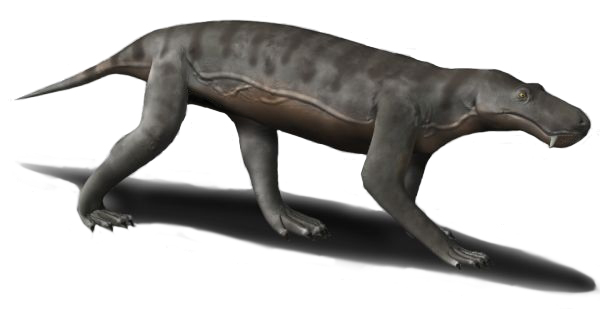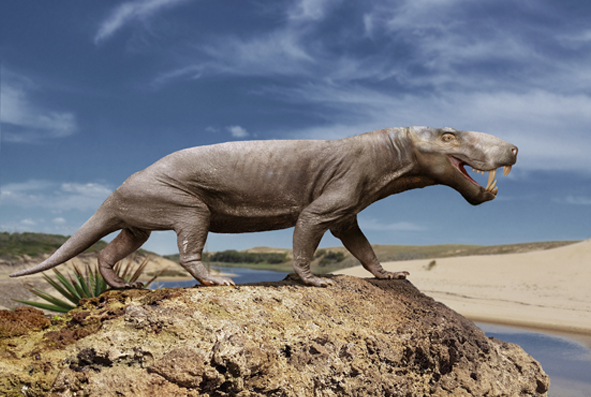|
Eoarctops
''Eriphostoma'' is an extinct genus of gorgonopsian therapsids known from the Middle Permian (middle Capitanian stage) of ''Tapinocephalus'' Assemblage Zone, South Africa. It has one known species, ''Eriphostoma microdon'', and was first named by Robert Broom in 1911. It is the oldest known gorgonopsian and among the smallest and most basal members of the clade. Description Gorgonopsians were a morphologically conservative group, and like all gorgonopsians, ''Eriphostoma'' would have been a quadrupedal predator. It was among the smaller members of the group, with a skull less than long. It had a relatively short, deep snout and large orbits compared to other gorgonopsians. Like all gorgonopsians, it had five incisors and a canine tooth on each side of the upper jaw, but it had only three small postcanine teeth in its maxilla. The palate of ''Eriphostoma'' has delta-shaped palatine bosses covered in numerous teeth, like ''Gorgonops'' and many basal therapsids, but not more de ... [...More Info...] [...Related Items...] OR: [Wikipedia] [Google] [Baidu] |
Gorgonopsia
Gorgonopsia (from the Greek Gorgon, a mythological beast, and 'aspect') is an extinct clade of sabre-toothed therapsids from the Middle to Upper Permian roughly 265 to 252 million years ago. They are characterised by a long and narrow skull, as well as elongated upper and sometimes lower canine teeth and incisors which were likely used as slashing and stabbing weapons. Postcanine teeth are generally reduced or absent. For hunting large prey, they possibly used a bite-and-retreat tactic, ambushing and taking a debilitating bite out of the target, and following it at a safe distance before its injuries exhausted it, whereupon the gorgonopsian would grapple the animal and deliver a killing bite. They would have had an exorbitant gape, possibly in excess of 90°, without having to unhinge the jaw. They markedly increased in size as time went on, growing from small skull lengths of in the Middle Permian to bear-like proportions of up to in the Upper Permian. The latest gorgonops ... [...More Info...] [...Related Items...] OR: [Wikipedia] [Google] [Baidu] |
Lycaenops
''Lycaenops'' ("wolf-face") is a genus of carnivorous therapsids. It lived during the Middle Permian to the early Late Permian, about 260 mya, in what is now South Africa. Description ''Lycaenops'' measured about and weighed up to . Like the modern-day wolves from which it takes its name, ''Lycaenops'' had a long and slender skull, with a set of dog-like fangs set into both its upper and lower jaws. These pointed canine teeth were ideal for the use of stabbing and/or tearing at the flesh of any large prey that it came upon. ''Lycaenops'' most likely hunted small vertebrates such as reptiles and dicynodonts. ''Lycaenops'' walked and ran with its long legs held close to its body. This is a feature found in mammals, but not in more primitive amniotes, early reptiles, and synapsids such as pelycosaurs, whose legs are positioned to the sides of their bodies. The ability to move like a mammal would have given ''Lycaenops'' an advantage over other land vertebrates, since it would ha ... [...More Info...] [...Related Items...] OR: [Wikipedia] [Google] [Baidu] |
Gorgonops
''Gorgonops'' (from el, Γοργών 'Gorgon' and 'eye, face', literally 'Gorgon eye' or 'Gorgon face') is an extinct genus of gorgonopsian therapsids, of which it is the type genus, having lived during the Late Permian (Wuchiapingian), about 260–254 million years ago in what is now South Africa. Despite its popularity, ''Gorgonops'' is a medium-sized gorgonopsian (about long maximum), regularly confused by the general public with the more massive ''Inostrancevia'', known from Russia, due to their similar appearance and the various media that tend to refer them by the name of the group they belong rather than by their genus names, which does not help in differentiation. History of discovery The holotype of the type species, ''Gorgonops torvus'', was in 1876 one of the first therapsids described, by Richard Owen, who also coined the name "Dinosauria" on the basis of the first known dinosaur fossils. It was also used as the type for which Richard Lydekker described the famil ... [...More Info...] [...Related Items...] OR: [Wikipedia] [Google] [Baidu] |
Arctognathus
''Arctognathus'' is an extinct genus of gorgonopsids that throve during the Late Permian in the Karoo basin of what is now South Africa. Discovery A carnivore, like all gorgonopsid, ''Arctognathus'' was given its name ("Bear jaw") in reference to its short and rounded snout. There is only one recognized species, ''A. curvimola''. Description It was a small gorgonopsid with a total length estimated at 1.1 m and an 18 cm skull. Classification Below is a cladogram from the phylogenetic analysis of Gebauer (2007): See also * List of therapsids This list of therapsids is an attempt to create a comprehensive listing of all genera that have ever been included in the Therapsida excluding mammals and purely vernacular terms. The list includes all commonly accepted genera, but also genera tha ... References Bibliography * * Gorgonopsia Prehistoric therapsid genera Lopingian synapsids of Africa Fossil taxa described in 1911 Taxa named by Robert Broom Lo ... [...More Info...] [...Related Items...] OR: [Wikipedia] [Google] [Baidu] |
Suchogorgon
''Suchogorgon'' is an extinct genus of gorgonopsid Gorgonopsia (from the Greek Gorgon, a mythological beast, and 'aspect') is an extinct clade of sabre-toothed therapsids from the Middle to Upper Permian roughly 265 to 252 million years ago. They are characterised by a long and narrow skull, ...s from Russia. It was a medium-sized animal with a low, narrow skull. Its skull is dotted with small pits, which might have housed sensory organs in life. Its canines were large and flat as in most gorgonopsids. References Gorgonopsia Prehistoric therapsid genera Fossils of Russia {{paleo-therapsid-stub ... [...More Info...] [...Related Items...] OR: [Wikipedia] [Google] [Baidu] |
Sauroctonus
''Sauroctonus'' (from el, σαῦρος , 'lizard' and el, κτόνος , 'murderer') is an extinct genus of therapsids. ''Sauroctonus progressus'' was a large (2 m long) gorgonopsid that lived in the Late Permian epoch before the Permian-Triassic extinction event that wiped out many life forms on Earth (259-254 million years ago). Its fossils have been found in the Usili Formation (Songea Group) of Tanzania and the Sokolki Assemblage Zone of the Volga Basin of Russia. Description ''Sauroctonus's'' flattened, triangular skull was about long, with a parietal eye, a primitive character, on the crown. The upper and lower jaw each contained one pair of massive canine teeth (the upper pair was larger); the other teeth were smaller, but were also sharp and pointed. In addition, minute, blunt teeth were present on the palatine bones. The lower jaw was widened to form a kind of chin. The long, lightly built, five-toed limbs bore a resemblance to mammals' limbs, but despite its ' ... [...More Info...] [...Related Items...] OR: [Wikipedia] [Google] [Baidu] |
Pravoslavlevia
''Pravoslavlevia'' is an extinct genus of gorgonopsian therapsids that lived in the late Permian and is part of the Sokolki subcomplex of Russia. It had a skull long. The total length of the animal was about . Only one species (''P. parva'') is known. Classification The following cladogram showing the position of ''Pravoslavlevia'' within Gorgonopsia follows Kammerer and Masyutin, 2018: See also * List of therapsids This list of therapsids is an attempt to create a comprehensive listing of all genera that have ever been included in the Therapsida excluding mammals and purely vernacular terms. The list includes all commonly accepted genera, but also genera tha ... Sources paleodb.org Gorgonopsia Prehistoric therapsid genera Extinct animals of Russia Fossil taxa described in 1953 {{paleo-therapsid-stub ... [...More Info...] [...Related Items...] OR: [Wikipedia] [Google] [Baidu] |
Inostrancevia
''Inostrancevia'' is an extinct genus of carnivorous therapsids, containing the largest members of gorgonopsians, predators characterized by long, saber-tooth-like canines. The various species inhabited European Russia during the Upper Tatarian (Vyatskian), a Russian regional stage equivalent to the Wuchiapingian and Changhsingian stage of the Late Permian period, dating from approximately 259 to 252.3 million years ago. The genus name was described posthumously, after the Bolshevik Revolution, by the Russian paleontologist Vladimir P. Amalitsky in 1922, in honor of geologist Aleksandr Inostrantsev. The first fossils attributed to ''I. alexandri'' are found in Arkhangelsk Oblast, near the Northern Dvina at the end of the 19th century, making it the first gorgonopsian known from Russia, the only place outside Africa where they are officially recognized. Some fossils of the species in question are among the most complete remains of gorgonopsians ever identified to date, t ... [...More Info...] [...Related Items...] OR: [Wikipedia] [Google] [Baidu] |
Middle Permian
The Guadalupian is the second and middle series/ epoch of the Permian. The Guadalupian was preceded by the Cisuralian and followed by the Lopingian. It is named after the Guadalupe Mountains of New Mexico and Texas, and dates between 272.95 ± 0.5 – 259.1 ± 0.4 Mya. The series saw the rise of the therapsids, a minor extinction event called Olson's Extinction and a significant mass extinction called the end-Capitanian extinction event. The Guadalupian was previously known as the Middle Permian. Name and background The Guadalupian is the second and middle series or epoch of the Permian. Previously called Middle Permian, the name of this epoch is part of a revision of Permian stratigraphy for standard global correlation. The name "Guadalupian" was first proposed in the early 1900s, and approved by the International Subcommission on Permian Stratigraphy in 1996. References to the Middle Permian still exist. The Guadalupian was preceded by the Cisuralian and followed by ... [...More Info...] [...Related Items...] OR: [Wikipedia] [Google] [Baidu] |
Smilesaurus
''Smilesaurus'' is an extinct genus of gorgonopsian known from Africa. It lived during the Late Permian. It contains the single species ''S. ferox''. Description ''Smilesaurus'' was a large gorgonopsian, with a skull length of up to 31 centimeters. It is characterized by extremely long canine teeth, and has the proportionally longest canines of any gorgonopsian. Unlike other gorgonopsians, which probably hunted similarly to predatory reptiles, ''Smilesaurus'' probably was a true saber-toothed predator which hunted using similar tactics to saber-toothed cat Machairodontinae is an extinct subfamily of carnivoran mammals of the family Felidae (true cats). They were found in Asia, Africa, North America, South America, and Europe from the Miocene to the Pleistocene, living from about 16 million until ...s. It can be distinguished by other rubidgeines by its lack of cranial pachyostosis and rugosoties, and by its relatively small orbits. Classification The classification of ''S ... [...More Info...] [...Related Items...] OR: [Wikipedia] [Google] [Baidu] |


.jpg)




